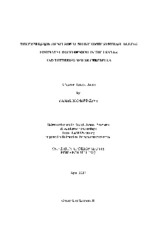| dc.creator | Zeve, Daniel Richard | |
| dc.date.accessioned | 2013-02-22T20:41:15Z | |
| dc.date.available | 2013-02-22T20:41:15Z | |
| dc.date.created | 2003 | |
| dc.date.issued | 2013-02-22 | |
| dc.identifier.uri | https://hdl.handle.net/1969.1/ETD-TAMU-2003-Fellows-Thesis-Z426 | |
| dc.description | Due to the character of the original source materials and the nature of batch digitization, quality control issues may be present in this document. Please report any quality issues you encounter to digital@library.tamu.edu, referencing the URI of the item. | en |
| dc.description | Includes bibliographical references (leaves 43-52). | en |
| dc.description.abstract | Tottering and leaner mice carry different mutations in the portion of their genetic information (tottering locus) that encodes for the α₁[A] subunit of P/Q-type voltage-gated calcium ion channels. These channels, located on the cell membrane, allow calcium ions in and out of the cell. The mutations in both mice lead to the production of abnormal calcium channels (mostly in the cerebellum), and these defective channels cause decreased entry of calcium ions into the cell. The tottering mutation is the less severe of the two, with leaner mice exhibiting a more severe cerebellar dysfunction as well as neuronal cell death. In several areas of the central nervous system, neuronal development, synaptogenesis, and neuronal death are thought to be directed in some part by nitric oxide (NO), which is regulated through control of its production by neuronal nitric oxide synthase (neuronal NOS). The expression of neuronal NOS/NO is regulated by calcium ion signaling and it has been shown that abnormal calcium ion flux in adult tottering and leaner mice affects neuronal NOS expression in these mice. We analyzed the expression of neuronal NOS in wild-type, tottering and leaner mice during postnatal cerebellar development. Using western blotting, NADPH diaphorase histochemistry, an indirect marker for neuronal NOS, we confirmed previous reports of transient expression of neuronal NOS in wild-type cerebellar Purkinje cells at postnatal day (P) 8 and basket cells at P12. We also observed an increase of neuronal NOS expression at P12 in tottering and leaner cerebella compared to the wild-type cerebellum, as well as an increase in neuronal NOS expression at P20 in tottering cerebellum compared to wild-type. This suggests that NO may be involved in early postnatal cerebellar development, and that tottering and leaner postnatal cerebellar development are altered compared to wild type mice. This work was supported in part by CERH NIEHS grant P30-EF09106 | en |
| dc.format.medium | electronic | en |
| dc.format.mimetype | application/pdf | |
| dc.language.iso | en_US | |
| dc.publisher | Texas A&M University | |
| dc.rights | This thesis was part of a retrospective digitization project authorized by the Texas A&M University Libraries in 2008. Copyright remains vested with the author(s). It is the user's responsibility to secure permission from the copyright holder(s) for re-use of the work beyond the provision of Fair Use. | en |
| dc.subject | biomedical science. | en |
| dc.subject | Major biomedical science. | en |
| dc.title | The expression of neuronal nitric oxide synthase during postnatal development in the leaner and tottering mouse cerebella | en |
| thesis.degree.department | biomedical science | en |
| thesis.degree.discipline | biomedical science | en |
| thesis.degree.name | Fellows Thesis | en |
| thesis.degree.level | Undergraduate | en |
| dc.type.genre | thesis | en |
| dc.type.material | text | en |
| dc.format.digitalOrigin | reformatted digital | en |


